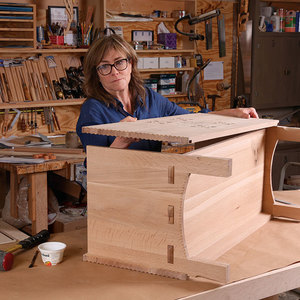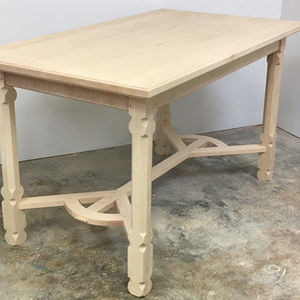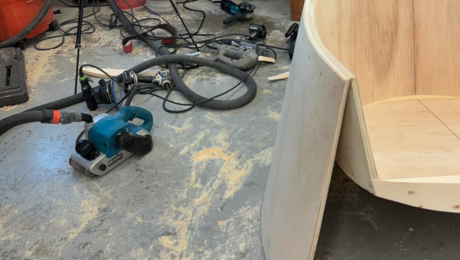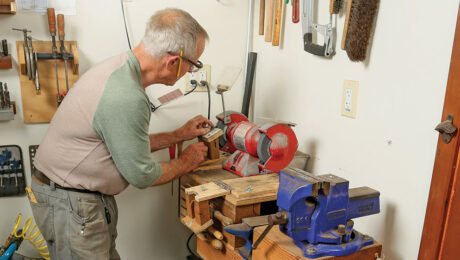Going Pro as a Furniture Maker
Another real-life example of a woodworker who made his dream a realityThere were so many great success stories of woodworkers going pro in issue #235 that we couldn’t fit them all into the pages of the magazine. Here is another admirable story that we thought was too good to be left untold…
Working the Online Angle

Peter HarrisonMiddle Grove, New York
Working alone in the shop he built by his house in rural Middle Grove, New York, not far from Saratoga Springs, Peter Harrison makes cutting-edge furniture in small batches, blending components of wood, concrete, and steel. He’s a meticulous, highly organized craftsman, and he has the construction for each piece of furniture thoroughly mapped out. This streamlining of his process enables him to build impeccably crafted furniture relatively quickly.
Soon after graduating from the furniture making program at Rochester Institute of Technology in the mid-1990s, Harrison began showing his work at three or four craft fairs per year, and that’s how he found most of his customers for a decade. But since 2008 that strategy has been far less effective. “For me, the shows have been very hard hit,” he says.
For some years he also had a good wholesale business going. But that too has faded with the recession, as many of the shops that sold his work have gone out of business. All this has galvanized Harrison’s natural inclination to represent himself-and to do it online.
Since well before the recession hit, Harrison had been selling some of his work through the online gallery Artful Home, which has a printed catalogue to supplement its online presence. Artful Home sells a carefully curated selection of furnishings, craft and art in a variety of mediums. Business through Artful Home was brisk for Harrison for several years, but the recession has hit hard, and his sales have fallen markedly.
Harrison has also experimented with selling through sites like Home Portfolio, a directory of home furnishings where the maker pays to improve placement of his work. And he’s tried Houzz, another site that presents furnishings by a wide range of designers. At Houzz, a maker can simply upload images and create a folder of work for free. Harrison has had some success with sales through both these sites.

 Harrison regularly scours design and gallery sites to see which might suit his furniture, and he is frequently approached by design blogs and gallery sites wanting to feature his work. To help assess which opportunities might be helpful, he uses Alexa, a site that ranks traffic on every site on the Internet. Alexa provides the service free, while also offering analytics for a fee to website owners.
Harrison regularly scours design and gallery sites to see which might suit his furniture, and he is frequently approached by design blogs and gallery sites wanting to feature his work. To help assess which opportunities might be helpful, he uses Alexa, a site that ranks traffic on every site on the Internet. Alexa provides the service free, while also offering analytics for a fee to website owners.
An early and avid adopter of digital technologies and a self-described “stat-nerd,” Harrison now conducts a good portion of his marketing-and makes many of his sales-without meeting the customer. This is particularly challenging, he says, since the story behind the work is “a huge part of why someone will buy. The connection to the maker is vital in selling hand-built furniture.” So he’s had to find virtual means to make that connection.
Through his website and his blog he’s trying to give customers a view into the life and process behind his furniture. He frequently posts snapshots of work in progress and writes about what he’s making and doing. He uses the blog to communicate but also, since blogs are catnip to Google, he uses it to optimize the ranking and the number of hits his site receives.
Harrison uses email blasts to communicate with his 400-person email list, and is careful not to use it too often-maybe three to five times per year. He uses a service called Campaign Monitor to manage his mass emailing. The advantage of using a service, he says, is that they know how to avoid spam filters; they tell you who is opening emails and who is deleting them; they also control how your email will look on anyone’s computer. And they make it easy for someone to unsubscribe. They also weed out addresses that bounce. Harrison pays $5 per email blast and 1 cent for every email it sends-so $9 several times a year. There are also free email services, like Mail Chimp.
At one point, Harrison hired a PR consultant, who would write full press releases and send them out to print and online media whenever Harrison had a new piece of furniture or an upcoming show. Harrison ended the arrangement after half a year. “Having watched him do it,” Harrison says, “I learned I can run my own PR campaign.” I think full releases can be a turnoff, so I do briefer writeups and send them to fewer outlets-maybe 10, all of them places that have published my work-or where I’d like to see it.
In the current climate, Harrison says, “there’s no one solution. If you can’t push on multiple fronts, it’s not going to work. You need to shake every tree to get enough nuts to fill the barrel.”
To learn more about Peter’s woodworking and business, visit www.peterharrison.com.
On a recent visit to Christian Becksvoort’s shop in Maine, where he’s devoted thirty years to making Shaker furniture, we saw this hand-written quote on a card tacked to the wall: “Being good in business is the most fascinating kind of art.” -Andy Warhol.



























Log in or create an account to post a comment.
Sign up Log in